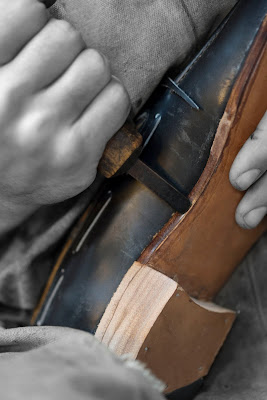Another week, another career, fellow shoemakers
In addition to my credentials as a master shoemaker, I have embarked on a second career in modelling. Any of you who may walk down Vigo St, will see a (very) large photo of yours truly in the window of Gieves and Hawkes. Fame at last you might say.
Unfortunately, I do not foresee as much success in this new occupation. The Other One's reaction was "When is it due?". Harsh in my opinion, but I can see her point. I blame it on an unfortunate apron malfunction. And there is nothing I can do about my face, so I think I will stick to making finely crafted custom made shoes.
People ask me what makes a bespoke shoe stand out from a factory shoe. How can you tell if someone is wearing bespoke shoes? Well, there are some give away signs. The principle one in my mind, is the mythical bevelled waist - that part of the sole leading up to the heel where the shoe is pulled in and given an elegant curve.
The bevelled waist is folded up against the upper using a combination of skilled skiving with a knife; preparation work; and a special iron. The result is unmistakable and cannot be reproduced well by a machine.
The effect is to narrow the waist and hide the welting stitches, giving a pleasing flow to the shoe.
Signs to look out for are the transition between the sole edge and the bevelled waist edge. This should be seamless and smooth. It is highly skilled and takes a long time to master. The other key element is the tightness of the bevelled edge to the upper. There should be no gap and you should not be able to see the ugly structural stuff underneath which is holding the shoe together.
So if you want to tell if is bespoke or not, then look at the waist. But you know, if you are wearing the bespoke shoes yourself, then you don't care so much about the waist, bevelled or not. Why? Because you care more about how they feel on your foot; how they fit you perfectly; how they caress instead of rub your feet; how when you are walking all day from one place to the next you do not even notice you have them on. That to me is the joy of a bespoke shoe.
And you know what else? Once you try them, it's hard to go back. Like so many of the finer things of life, I suppose.
Now then, back to shoemaking. My little pearl this week is a tiny and inconsequential thing called a side lining (are you detecting my ambivalence?). This is an extra piece of leather which is inserted between the lining and the upper, from the end of the stiffener to the toe puff.
Why use them? Well, they add substance to this area of the shoe which can, over time, sag out with the pressure of the toes. When I was an apprentice with Lobb, they insisted on putting them in every shoe. I do not adhere to this practice.
If the upper and lining are substantial, then I don't. If there is a wing cap, likewise. If the foot is slender, also. If the shoe needs to be lightweight or for a hot climate. And if I can't be bothered to make them (that is a joke).
I have a little cardboard pattern and cut out 4 side linings, reversing 2 of them for inside and outside.
You then have to skive to nothing along the edge that will be on top so that you cannot see an ugly ridge.
When ready, you dab a bit of paste on both sides and place them between the stiffener and the upper, making sure they are long enough to go over the toe puff.
Then last your shoe as normal.
At the stage where you shape your toe puff, you must glue down and shape your side linings so that they are invisible under the upper. Et voila.
Hope that helps all you budding shoemakers. Let me know if you want any specific areas covered.
Until next week, happy shoemaking!





